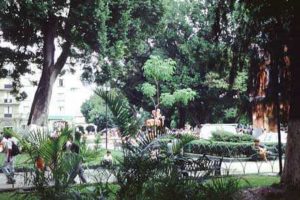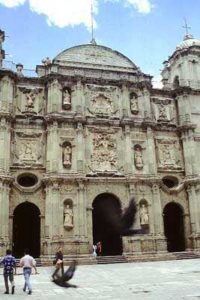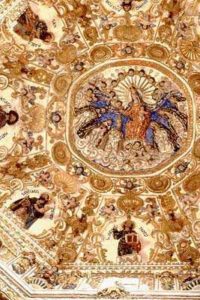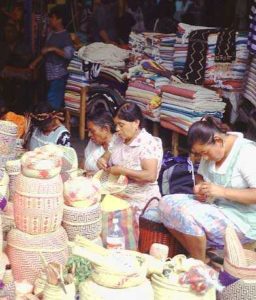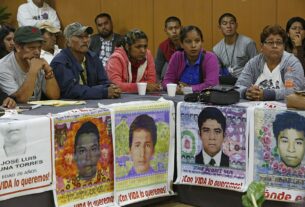Morning.
Given the long and illustrious history of Mexico, it is only fitting that just a few kilometers to the east of the oldest urban center in the Americas is one of the loveliest present-day cities in the Americas – the city of Oaxaca. All visitors to Mexico should consider Oaxaca (pronounced Wah-hah-cah) a “must-see”. Over the centuries, Oaxaca has become particularly adept at preserving the old and the interesting, while simultaneously keeping pace with the demands of even the most discerning foreign visitor.
And by “discerning”, I do not wish to imply “wealthy”, as do so many these days, but rather appreciative of quality and value for money in accommodations, food, souvenir purchases, art galleries and sightseeing. Your personal budget is irrelevant. Oaxaca is a city for everyone and one of the inevitable consequences of any stay there is the intermingling of the really wealthy, even aristocratic, with impoverished backpacking bohemians – in the markets, sitting around the plaza and in visits to the numerous archaeological sites nearby.
Tourists here don’t simply visit – they discover their own Oaxaca, their own favourite places to eat, sit, shop and sip a pre-dinner cocktail. And many return, time after time, finding more things to do with each visit.
Of necessity, therefore, these suggestions for a “Day in Oaxaca” are nothing more that a personal anthology of treats and surprises. They continue to entice me, on my periodic return visits, just as they did more than twenty years ago when I first made the acquaintance of this venerable city. You will no doubt make your own discoveries, add your own special delights.
Alameda de Léon
Putting aside for a while such mundane time-fillers as looking for a suitable hotel, let’s start in the heart of downtown, sipping freshly-brewed, locally-grown coffee in one of the cafés fronting the main plaza. The locals call their plaza the Zócalo, though in strict usage the term is reserved only for that great, now-barren square in the centre of Mexico City. Here in Oaxaca, a Moorish-looking kiosko in the middle of the square is shaded by lovely trees. The term “Zócalo” was used simply in imitation, the sincerest form of ….
But the use of the term does not imply that Oaxacans look up to the capital city. Oaxacans are far more proud of their own fine city, just as they are of their state’s most famous son, the revered nineteenth century national president, Benito Juárez.
Despite being built on undulating land, Oaxaca is one of the most regularly laid-out cities in Mexico. In fact, the character of the local terrain is said to be why the settlement was first christened Antequera, after the town in Spain which was also built on uneven land. Oaxaca’s street plan was set out by a mathematician, Alonso García Bravo, who also redesigned Mexico City after the fall of Tenochtitlan. He must have liked his design since he lived out the remainder of his life here in Oaxaca.
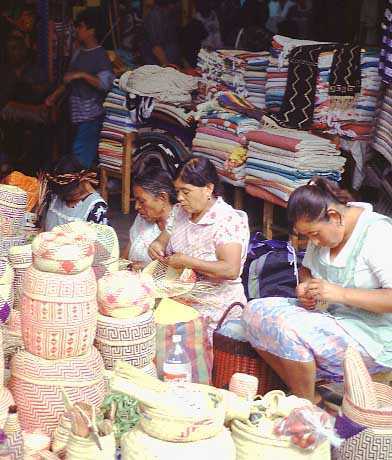
Finishing my cup of coffee and fancy sweet rolls takes longer than I thought, mainly because of the steady procession of young boys and girls table-hopping with their varied wares and sales pitches. Reluctant to take “no” for an answer, they insist that I examine their jewelry, stroke their onyx animals and admire their brightly-patterned rugs – even if I don’t buy anything.
I stretch my legs in the direction of the cathedral, a short block away fronting on the small Alameda de León plaza. Sitting on a shady bench admiring the cathedral’s magnificent ornate facade, I am momentarily distracted by a balloon salesman whose multicolored balloons contrast splendidly with the building’s greyish rock. Somehow, the cathedral seems more squat and massive than when I was here last time. Perhaps the numerous seismic shakes in this region have forced it to shrink into the ground in self-defense. The city and its plethora of superb buildings have often suffered minor damage as a result of the geological and social upheavals that have punctuated the seismic centuries since the Spanish first arrived.
Every time I look inside the cathedral, I hope to find that I was mistaken in dismissing it so casually the last time I saw it; however, the cool air that greets me as I step through the doorway perfectly anticipates my sense of disappointment at the relative lack of interest that the interior holds, at least from my unashamedly irreligious perspective.
I step outside again, into the bright and welcoming sunlight, and turn the corner. Sauntering along the rather arty, pedestrianized promenade (Andador de Macedonia Alcalá), I drift past attractive shop fronts and enticing doorways, many marked with commemorative, historical plaques. A steady stream of tourists trickles past me. I wonder whether my next destination, the church of Santa Domingo, will this time fail to provide me with the sense of amazement and astonishment that it has always invoked on previous occasions. I fear I may be disappointed, just as I was on entering the cathedral.
I delay my arrival at Santa Domingo by ducking into the Museum of the City of Oaxaca to gaze at the current exhibit of contemporary art in two of its upstairs rooms. This building was supposedly built by Hernán Cortés, the famous conquistador. Though intended for his personal use, he never lived here. Then I dive into a craft store, inhaling silently at the prices and mentally calculating probable profit margins. If only the artesans themselves could charge this much! A gaggle of chattering Europeans shields the till, each waving a credit card. It’s not like my first visit, when international credit cards were virtually useless.
Here, across a small garden, is the imposing exterior of Santo Domingo. I hesitate again, looking above the doorway for St. Hippolytus the Martyr, the patron of the Dominican province which was centred on Oaxaca. There he is, wearing his Roman soldier’s uniform, with a plumed helmet at his feet, helping Saint Dominic support the church. At several places on this west-facing facade, which for maximum effect deserves being seen in the late afternoon sun, are Dominican dogs, holding torches.
I can’t put off the moment any longer. Prepared to be disappointed, I step inside…
Part 2
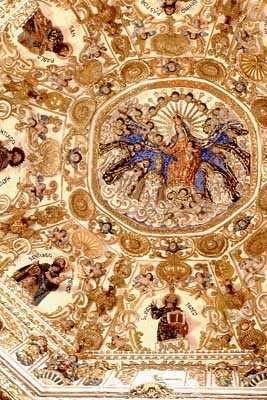
Breathtaking! This, in the understated words of Richard Perry, the author and renowned expert on colonial religious architecture, is the “most sumptuous baroque interior in Mexico.” Aldous Huxley was more forthcoming, describing Santo Domingo as “one of the most extravagantly gorgeous churches in the world”. Perhaps the most spectacular single element is overhead, beneath the choir: an incredibly detailed, colorful and branching Tree of Life depicting the lineage of Felíx de Guzmán, the founder of the Dominican Order. But the entire church is alive with color and ornament. It is one of those sights that mere words are woefully inadequate to describe, but if words are all we can use, then perhaps Kate Simon’s prose in “Mexico: Places and Pleasures” comes closer than most: “Imagine a tree with a thousand branches, all of thick gold, and among the golden leaves, polychrome figures and ornaments, the whole overwhelming tangle backed by dazzling white to make the most baroque of churches, and one of the most beautiful.” This incredible riot of gold and glory, this exuberance of wealth – who can guess what personal sacrifices and tithes were required to build it?
Even the knowledge that the impressive retablos, or alterpieces, are actually modern reproductions, replacing those destroyed in the nineteenth century, does nothing to diminish my pleasure at seeing Santo Domingo again. The Dominican priory was dissolved in 1859 when Benito Juarez’s first administration passed the Reform Laws separating Church from State. Three years later, at the time of his second presidency, the priory was temporarily converted into an army barracks and the church used as horse stables. In 1869, during Juarez’s third presidency, a local administrator authorized the retablos to be destroyed. While the church was re- opened for worship in 1902, the Dominicans did not return until 1938.
Next to Santo Domingo, occupying part of the magnificent building that was originally the priory, is the state’s Regional Museum. Even though I only have a short time available, I pay the entrance fee (unless it’s a Sunday, when it’s free!) and stroll inside to admire the building, with its beautifully proportioned cloisters. Ignoring distractions, I head straight for the museum’s great highlight – the pre-Hispanic Mixtec artifacts found in Monte Alban’s fabled Tomb 7. In Tomb 7, dating back to about 500 A.D., several hundred pieces of superb craftsmanship, sculpted in kilos of gold and silver, turquoise, crystal and obsidian, accompanied the remains of a dozen individuals on their way to the afterworld. The gold items are truly magnificent, priceless reminders of early metalworking skills. Even at today’s low prices, the metal alone is worth some 40,000 dollars.
The Mixtec were consummate artists. Unfortunately, most of their numerous concertina-folded codices, which used complex glyphs and designs to record a variety of subjects, were destroyed by Spanish priests as being the work of the Devil. A handful, however, survived. One, known as the Codex Vienna, is a land document depicting maguey plants and cacao pods; it eventually found its way into the Austrian state library. Another, the 11- meter-long Nuttall Codex, relates matters of genealogy and history. Perhaps the most famous Mixtec artifact of all is the spectacular jade bat-god mask, with eyes and teeth of white shell, exhibited in the National Anthropology Museum in Mexico City.
Oaxaca’s Regional Museum houses numerous anthropological exhibits complementing the pieces found in Tomb 7. The state of Oaxaca has seven distinct regional divisions in which 16 languages and about 200 different dialects are still in use. Items from each of these regions are on display and provide a kind of instantaneous “Cook’s Tour” of the region. If only I had more time…
Leaving the museum, and crossing the street, I window-shop at a store named El Oro de Monte Alban (The Gold of Monte Alban) which sells high quality reproductions of the jewelry found in Tomb 7 and other similarly elegant items. On the same side of the street is the Institute of Graphic Arts, founded by artist Francisco Toledo, an avid collector of prints. I can’t resist walking inside and spending a few minutes perusing the exhibits, which include works by Rivera, Posada, Delacroix, Durer and Miró.
Exiting the building, I turn right and then right again, along Carranza street. One block west of Alcalá is García Vigil. A plaque outside number 609 marks the building as Benito Juarez’s first house when he came to the city in 1818 from his native village of Guelatao. Four rooms around a simple courtyard give an idea of what life was like in the early nineteenth century.
As I drift back towards the Zócalo, my mind wanders back to those times and it occurs to me that what Juárez, one Oaxacan-born president gave, or achieved, was largely taken away by his successor, Porfirio Diáz, also born in this state. The two may have had some Zapotec blood in common, but it failed to result in continuity of policy or similarity of interests. Juárez is often likened to Abraham Lincoln, but in that case, which Americano plays the part of Diáz the dictator?
Lunchtime in Oaxaca is best spent on or near the zócalo. In order to maximize my afternoon’s sight-seeing, I opt for a relatively fast light meal at La Casita, upstairs on Hidalgo, only a few steps from the Alameda de León. Here, the gastronomically adventurous can snack on chapulines (grasshoppers) or Sopa de Nada, which is best translated (literally) as Nothing Soup!
Afternoon
After lunch, I stroll across the zócalo and into the State Government Palace on the south side. A colorful mural in the stairwell tells the state’s history. The right wall is dominated by women, including the poet and nun, Sor Juana Inés de la Cruz. Sor Juana was born in San Miguel Nepantla, a tiny village near Cuernavaca in the state of Mexico, on November 12, 1651. November 12 is now National Book Day. She learned to read at the age of three and attended University classes at the age of eight. She later entered a convent and became one of Mexico’s greatest poets. Her personal library is said to have contained more than four thousand volumes. Historians now regard her as one of the pioneers of the women’s liberation movement, since she participated in discussions concerning theological matters previously dominated by men. Sor Juana did have some quirks. For instance, she is believed to have given up eating cheese after hearing from somewhere that it made people slow to learn. She was just 43 years old when she died during an epidemic that decimated her convent.
Another young woman depicted in the Government Palace mural also died tragically young. In the mural’s bottom left corner is the decapitated head of the last Zapotec princess, who was murdered at Monte Alban. When her lover, a Mixtec prince, found her, he committed suicide. His blood mingled with hers as it dripped into the Atoyac River far below.
Leaving the Government Palace, and seeking happier thoughts, I head back across the zócalo. Walking through the plaza as many times as possible in the same day always makes me feel like I belong here. Passing the cathedral, I turn left along Independencia, and crossing Porfirio Diaz street, I linger outside the Church of San Felipe Neri. This is where, in 1843, Benito Juárez married 17-year-old Margarita Maza. Curiously, he had shared a house with her parents before she was even born. Margarita must have been an amazing character, enduring numerous prolonged separations while Juárez was in political exile trying to rally his troops.
In those days, Mexican migrants in the U.S. had not yet begun to send back the vast sums of money to their families that they do today. In fact, in Juárez’s case, the flow of money was in the opposite direction. Margarita opened a shop in Etla, a village just outside Oaxaca, and regularly sent money to her husband in New Orleans. As I saunter further along the street, I wonder what the topics of conversation might have been if these three remarkable women who lived in three very different centuries had been able to meet over afternoon tea.
One block further, on Avenida Morelos is the Tamayo Museum of Pre-Hispanic Art.
Rufino Tamayo (1899-1991) was one of Mexico’s finest modern artists. The museum, however, does not house twentieth-century art but Tamayo’s vast collection of pre- Hispanic art, which he donated to the state, carefully arranged in five color-coordinated rooms, all designed by Tamayo. Rather than trying to revisit all the pieces in this collection, I prefer to focus on just three or four items in each room, trying to assimilate their details, imagining them in their original surroundings. The delightful well-rounded proportions of Colima figurines place them high among my personal favorites.
Returning to Independencia and heading further west is the Basilica de la Soledad. “Our Lady of Solitude” is the patron saint of Oaxaca; the festival in her honor begins just before Xmas on December 18th. According to local lore, this is the day when she first appeared, in a hermitage dedicated to another saint. First, a small chapel was built on the spot and later this church with its magnificently ornate facade and gold-leafed baroque altarpiece. The statuette of the Virgin sports a superb (and hefty) filigreed gold crown. Waiting in the adjacent small plaza are vendors of helados de garrafa – ice-creams handmade in wooden barrels of the kind your grandparents probably used. Rose- flavored ice-cream, anybody? Or perhaps you prefer lime or papaya?? Since I’ve invariably run out of energy by this stage of the afternoon, I succumb to temptation, select my helado and drift back to the center for a caffeine-laden coffee.
UNESCO has included Oaxaca in its list of places comprising the “cultural patrimony of mankind” and it’s easy to see why. Quite apart from the marvelous architecture and obvious history evident at every turn, the city also has a rich cultural life, culminating in various major festivals. Perhaps the most extraordinary is the Night of the Radishes on December 23rd. This festival is described in more detail elsewhere on Mexico Connect. Each year, campesinos bring their most noteworthy radishes, carved into sculptures representing scenes of daily life, religious events and well-known personalities. Street vendors sell hundreds of delicious buñuelos (somewhat like fried pancakes); the tradition is to ceremoniously smash the plate they have been served on, but only after first consuming every last morsel. The following day, December 24th, is marked by the Xmas calendas (Calendas Navideñas), processions preceding a fiesta and dinner.
This is a time when large crowds throng the zócalo to admire the parade of floats. Oaxacan customs can also be appreciated in the early part of the year, when carnival is celebrated, and at the beginning of November on the Day of the Dead. If the thought of visiting one of the local cemeteries gives you the creeps, then don’t despair because, downtown, rival groups compete to create the most decorative “Day of the Dead altar”.
Oaxaca’s single biggest annual party, in mid-July, has come to be known as La Guelaguetza , which is Zapotec for “offering” or “mutual help”. A massive open-air amphitheater is a permanent fixture on the side of the Fortín hill which overlooks the north west quadrant of the city. In July, this is the scene for spectacularly colorful regional folkloric dances performed by several different ethnic groups from the seven main geographic regions of the state.
The entire city comes alive with color. Color is everywhere from the beautifully hand-embroidered dresses and huipiles, to the food, to the paper streamers decorating the streets and to the mixture of merchandise sold on the sidewalks. Some central hotels, including the Camino Real, luxuriously housed in an architecturally-gorgeous former convent, and the Monte Alban opposite the cathedral, offer a once-a-week, year- round, scaled-down version of La Guelaguetza for travellers unable to visit in July.
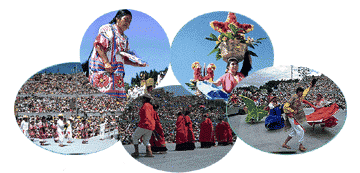
Evening
On this occasion, I’m visiting the city in a “between fiestas” month. But there is still plenty going on. The distinctive sounds of the marimba draw me back to the zócalo in the early evening to sit and listen to a marimba concert. On several previous visits, I have eaten an early supper in order to attend a concert in the Macedonio Alcalá Theater, a lovely building dating from the beginning of the century. But this time, I forgo a trip to the theater in order to enjoy a leisurely end-of-the-day dinner overlooking the plaza on the balcony of El Asador Vasco. There are several excellent restaurants in Oaxaca, but the location of El Asador Vasco can’t be beaten, particularly if you get a balcony table, since it affords a view over the goings-on in the plaza below. If you prefer quieter surroundings, then my personal favorite for quality food in an elegant atmosphere is the Del Vitral restaurant, on Guerrero street.
As I dine, I reflect that, as usual, I’ve failed to do everything I wanted to during the day. Somehow, I never visited any of the markets. Oh well, there’s always mañana…
Copyright 1999 by Tony Burton. All rights reserved.

